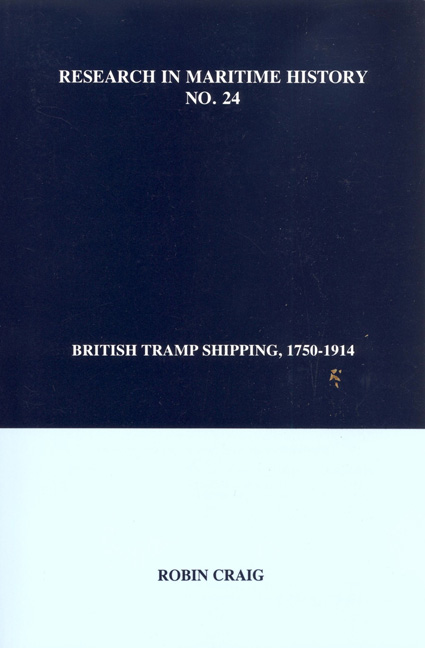Book contents
- Frontmatter
- Contents
- Introduction
- Tramp Shipping and Ownership
- The Trades
- The Seamen
- Tramp-Shipping Regions
- A. Wales
- “Industrial Glamorgan: The Ports and Shipping, c. 1750-1914”
- “Trade and Shipping in South Wales - The Radcliffe Company, 1882-1921”
- “The 1860s at Llanelli - A Dynamic Decade for Trade and Shipping”
- “Carmarthenshire Shipping in the Eighteen Forties”
- “Hetty Ellen of Aberystwyth and Doctor Livingstone”
- B. The Northwest
- C. The West Country
- D. The Northeast
- E. The Southeast
- F. The British Empire: Maritime Canada
- Bibliography
“Industrial Glamorgan: The Ports and Shipping, c. 1750-1914”
from A. Wales
- Frontmatter
- Contents
- Introduction
- Tramp Shipping and Ownership
- The Trades
- The Seamen
- Tramp-Shipping Regions
- A. Wales
- “Industrial Glamorgan: The Ports and Shipping, c. 1750-1914”
- “Trade and Shipping in South Wales - The Radcliffe Company, 1882-1921”
- “The 1860s at Llanelli - A Dynamic Decade for Trade and Shipping”
- “Carmarthenshire Shipping in the Eighteen Forties”
- “Hetty Ellen of Aberystwyth and Doctor Livingstone”
- B. The Northwest
- C. The West Country
- D. The Northeast
- E. The Southeast
- F. The British Empire: Maritime Canada
- Bibliography
Summary
Introduction
From the early eighteenth century the harbours of Glamorgan played an essential role in the economic life of the county. The sea was the crucial medium of communication for both agriculture and industry, and without this linkage, neither sector of the economy could have effected the economic transformation of the eighteenth and nineteenth centuries. Bristol was for much of the period the major generator of agricultural demand for a large part of the Bristol Channel region, and became equally important as the trans-shipment port for a great deal of Welsh iron, copper and tin plate destined for more distant overseas markets. Next in significance to Bristol were trading links in agricultural products with Devon, Somerset and Cornwall: with each of these counties there were continuing interchanges of farm produce - most, if not all, of it carried by sea in the numerous “market boats,” mainly of between thirty and sixty tons burthen. In Glamorgan's growing industrial output in the eighteenth century, dependence upon the sea was no less pronounced. The coal industry relied heavily upon the seaborne coal trade, and the development of both ferrous and non-ferrous metal-smelting necessitated the employment of much shipping for the carriage of raw materials and manufactures. Sea transportation was encouraged by the geographical features of the county. The estuaries of the rivers Taff, Neath, Tawe and Loughor provided safe havens for at least small vessels of up to 100 tons; but the rise of tide which was characteristic of Bristol Channel ports was a mixed blessing. On the one hand it did permit relatively large vessels to enter the harbours on spring tides, but the time required to load and discharge such larger vessels resulted in great delay, as departure would be hindered by the ensuing neap tides. The north-south orientation of the valleys which were the main arteries of trade naturally communicated with these havens, where it was relatively easy to construct small harbours and quays. The polarity of these lines of communication contrasted markedly with the relatively imperfect links which lay on an east-west axis. Given the inherent cost advantage of water transport it is not difficult to appreciate the importance of the sea to the county's developing economy.
- Type
- Chapter
- Information
- British Tramp Shipping, 1750–1914 , pp. 137 - 186Publisher: Liverpool University PressPrint publication year: 2003



